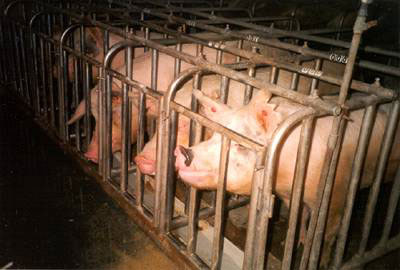Group explores alternatives to gestation stalls

For swine producers considering switching from housing pregnant sows in stalls to group based loose housing, the VIDO Swine Technical Group (VSTG) recommends first looking at the other available options.
Gestation stalls, which measure about two feet by seven feet (0.6m to 2.1m), are designed to eliminate the aggression common in group housing systems but they raise other welfare concerns.
Loose housing
The VSTG group consists of pork producers, engineers, veterinarians, researchers and extension people and has been busy gathering information on different kinds of loose housing systems in order to assist pork producers in making informed decisions. .
Chairman of the VSTG, Lee Whittington, pointed out that the concept of loose housing has been around for a while stating that “If you go back 25 or 30 years ago we had sows in small groups and, of course, the concern was when you mix sows into small groups there’s a lot of fighting and pushing and shoving at the time of mixing.”
Crates were developed to tackle this problem which offered the ability to protect the sow during the day, give her access to feed and to check on her health without the necessity of battling through a group to look after her.
It has been proven that by increasing group size, aggression among pigs reduces.
A number of options exist for producers – electronic sow feeding, trickle feeding, floor feeding, cafeteria style systems – the advantages and disadvantages of such, need to be carefully evaluated.
Positive example of ESF systems
Acting on a concern that welfare groups’ activity would increase, the Alberta Pig Company moved to a Straw Based ESF System.
Production manager, Tony Nicol, noted that electronic sow feeding is one system for keeping sows loose housed but it is the only system that will guarantee that each sow will get exactly what she should get.
“Other systems,” he commented “rely on trough feeding or floor feeding and do not allow the opportunity to individually feed the sow”.
More relaxed sows are easier to handle and can be found in electronic sow feeding as well as in other loose housed sow systems.
When the sows are mixed, aggression can become a problem for the Pig Company. Nicol stated that within the first 48 hours aggression is at its highest, but it quickly subsidies as the animals learn to avoid the bullies among the group.
Downside to ESF systems
“Electronic sow feeding systems are complex with much electrical wiring and the equipment much be sturdy” said Nicol. “The system needs to be protected against mice and it cannot be easily installed in existing facilities. It is ideal for a new building”.
Floor feeding as Low Tech Alternative
Floor feeding is a system in which feed is dumped into the pens several times per day.
VSTG member, Franklin Kains, noted that this type of feeding is simpler, cheaper to install and to manage. “It uses less equipment and doesn’t get into a lot of electronics that some of the other systems do”.
The downside is that feeding sows must be carried out on a group basis and cannot be done individually. There is also considerably less aggression within this system.
Web Based Survey
The Swine Technical Group is conducting a nationwide web based survey of swine producers to gather additional information.
Details on how to participate in the online survey can be accessed at the Vaccine and Infectious Disease Organization web site at www.vido.org, the Banff Pork Seminar web site at www.banffpork.ca or the Prairie Swine Centre web site at www.prairieswine.com.
For the latest pig news, subscribe here











